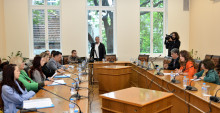Since Bulgaria's accession to the European Union, 373 km of railway lines have been modernised, as well as 8 key railway stations in the country. This was said by Deputy Minister of Transport and Communications Anna Natova during a meeting with Serbian media representatives, which took place today in the building of the Ministry of Transport and Communications. She pointed out that the benefits of Bulgaria's accession to the EU are indisputable and visible for all citizens and businesses.
‘400 km of highways and the longest road tunnel in Bulgaria — Zheleznitsa — have been built with EU funds. 32 Sofia metro stations and 33 km of metro lines have been built. Equipment for dredging on the Danube has been delivered to support year-round navigation. A river information system for the safe passage of ships on the Danube has been set up. An information system for the management of vessel traffic in the Black Sea has been developed’, Anna Natova explained.
The deputy minister added that other important projects of regional and European importance were also being worked on. The railway line from the Bulgarian-Serbian border to Burgas and the Turkish border is to be completed. Construction on the railway lines from South-Eastern Bulgaria to the border with the Republic of North Macedonia, as well as the railway line from North-Western Bulgaria to Sofia are priority areas for action.
‘In order to achieve high added value of the investments, it is important to have completion of the road and rail corridors, as well as interoperability with the transport networks of the neighbouring countries’, Anna Natova stressed. She pointed out that of great importance for the development of connectivity in the region is the construction of a new combined (road and rail) bridge over the Danube between Bulgaria and Romania at Ruse—Giurgiu.
‘All this is being implemented with significant financial resources under OP Transport 2007—2013, OP Transport and Transport Infrastructure 2014—2020, the Connecting Europe Facility and the National Recovery and Resilience Plan. One of the most important projects being implemented under the NRRP is the establishment of the air ambulance system’, Deputy Minister Natova added.
The Executive Director of Bulgaria Heli Med Service EAD Dimcho Dobrev presented the development of the air ambulance system in Bulgaria. The first A 109S Trekker helicopter arrived in Bulgaria on 1 February 2024. According to the contract with the Italian manufacturer Leonardo S.p., the remaining 5 helicopters are expected to be delivered in phases by the end of 2025. The construction of 6 operational bases for HEMS is also foreseen under the NRRP. The bases will be positioned to provide coverage of the country by at least two helicopters. The radius of operation of the helicopters is tailored to the requirement to provide emergency assistance within the ‘golden hour’. There are also currently 7 registered hospital heliports in the country. The missions to be performed are of two main types. Primary Missions: from the scene of an accident to a receiving hospital and Secondary Missions: hospital-to-hospital transport of teams, organs for transplantation and medical products.
The visit of the Serbian journalists was organised by the Delegation of the European Union in Belgrade, under the project ‘Bulgaria—EU neighbour and the guardians of the Union's eastern border’. The purpose of the visit is to get acquainted with the process of Bulgaria's accession to the EU and the benefits of our country's membership.

